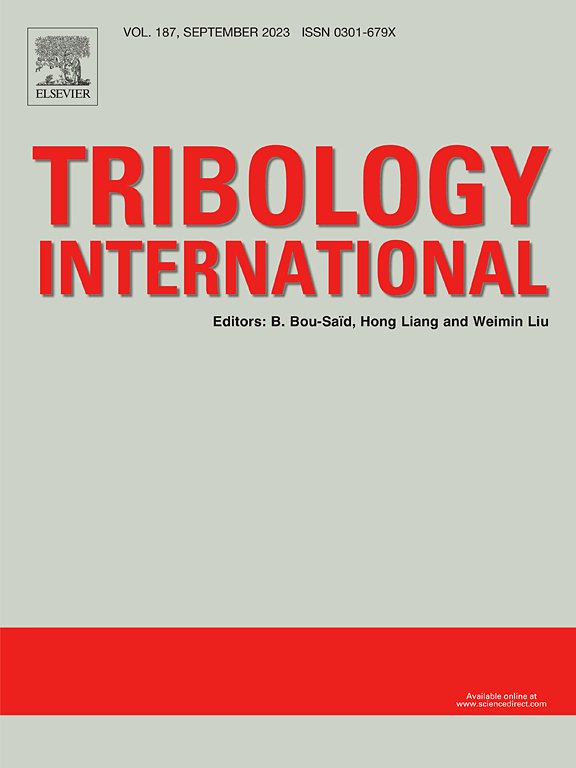Cumulative effect of FexN phases, roughness parameters, and asperity geometry on the anti-wear properties of low-temperature plasma nitrided Ti-Nb stabilized IF steel
IF 6.1
1区 工程技术
Q1 ENGINEERING, MECHANICAL
引用次数: 0
Abstract
Plasma-driven surface modification techniques like plasma nitriding (PN) are trending, especially for steel products. It is advantageous due to the higher order of process control and superior quality of property enhancement of the surface. This technique often employs a high processing temperature, which is one of its metallurgical and economical limitations. One of the renowned solutions is the implementation of lower processing temperatures. The current work is based on the low-temperature plasma nitriding of Ti-Nb stabilized interstitial-free steel at different processing temperatures ranging from 400 ºC to 500 ºC. The role of FexN phases, surface roughness parameters, and asperities geometry are thoroughly studied with respect to the anti-wear properties of the surface. The formation of γ′-Fe4N and ε-Fe2–3N are detected in the XRD plot, whereas α″-Fe16N2 is confirmed in microscopy. The sample treated at 450 ºC presents the best anti-wear properties compared to other samples, primarily due to the presence of prominent ε-Fe2–3N phase and blunt surface asperities. A maximum reduction in wear volume of about 3 times the base value is recorded in the wear test. The microscopic and elemental analyses are conducted on the wear scars, wear debris, and counter-body worn-out surfaces to study the wear mechanism comprehensively. The work tries to illustrate the wear mechanisms schematically to understand the conceptual grounds associated with such theories. The spectrometric analysis in the depth direction is also performed, and it detects the trace of nitrogen up to about 7 µm depth for 500 ºC nitriding conditions.
FexN相、粗糙度参数和粗糙度几何对低温等离子体氮化Ti-Nb稳定IF钢抗磨性能的累积影响
等离子体驱动的表面改性技术,如等离子体氮化(PN)是趋势,特别是对钢铁产品。其优点是工艺控制层次高,表面性能增强质量好。该技术通常采用较高的加工温度,这是其冶金和经济限制之一。其中一个著名的解决方案是实施较低的加工温度。目前的工作是基于Ti-Nb稳定的无间隙钢在400 ~ 500℃不同加工温度下的低温等离子体氮化。深入研究了FexN相、表面粗糙度参数和凸起几何形状对表面抗磨性能的影响。XRD图中检测到γ′-Fe4N和ε-Fe2-3N的形成,而显微镜下则证实α″-Fe16N2的形成。与其他样品相比,450℃处理的样品表现出最好的抗磨性能,这主要是由于存在显著的ε-Fe2-3N相和钝性表面凹凸。在磨损试验中记录的最大磨损量减少约为基础值的3倍。对磨损痕、磨屑、反体磨损面进行微观分析和元素分析,全面研究磨损机理。该工作试图图解说明磨损机制,以理解与这些理论相关的概念基础。还进行了深度方向的光谱分析,在500ºC的渗氮条件下,它可以检测到深度约7 µm的微量氮。
本文章由计算机程序翻译,如有差异,请以英文原文为准。
求助全文
约1分钟内获得全文
求助全文
来源期刊

Tribology International
工程技术-工程:机械
CiteScore
10.10
自引率
16.10%
发文量
627
审稿时长
35 days
期刊介绍:
Tribology is the science of rubbing surfaces and contributes to every facet of our everyday life, from live cell friction to engine lubrication and seismology. As such tribology is truly multidisciplinary and this extraordinary breadth of scientific interest is reflected in the scope of Tribology International.
Tribology International seeks to publish original research papers of the highest scientific quality to provide an archival resource for scientists from all backgrounds. Written contributions are invited reporting experimental and modelling studies both in established areas of tribology and emerging fields. Scientific topics include the physics or chemistry of tribo-surfaces, bio-tribology, surface engineering and materials, contact mechanics, nano-tribology, lubricants and hydrodynamic lubrication.
 求助内容:
求助内容: 应助结果提醒方式:
应助结果提醒方式:


